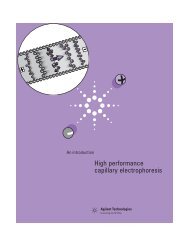- Page 1 and 2:
Agilent HPLCColumn Selection GuideE
- Page 3 and 4:
New columns deliver on the promise
- Page 5 and 6:
HPLC Column Selection GuidelinesHPL
- Page 7 and 8:
HPLC Column Selection GuidelinesQui
- Page 9 and 10:
HPLC Column Selection GuidelinesSma
- Page 11 and 12:
HPLC Column Selection GuidelinesSil
- Page 13 and 14:
HPLC Column Selection GuidelinesQui
- Page 15 and 16:
HPLC Column Selection GuidelinesMet
- Page 17 and 18:
HPLC Column Selection GuidelinesOpt
- Page 20 and 21:
HPLC Column Selection GuidelinesCar
- Page 22 and 23:
Columns for Analytical HPLCPoroshel
- Page 24 and 25:
Columns for Analytical HPLCEnvironm
- Page 26 and 27:
Columns for Analytical HPLCZORBAX E
- Page 28 and 29:
Columns for Analytical HPLCRapid An
- Page 30 and 31:
Columns for Analytical HPLCZORBAX E
- Page 32 and 33:
Columns for Analytical HPLCZORBAX E
- Page 34 and 35:
Columns for Analytical HPLCOOOOOCH
- Page 36 and 37:
Columns for Analytical HPLCColumn S
- Page 38 and 39:
Columns for Analytical HPLCZORBAX E
- Page 40 and 41:
Columns for Analytical HPLCZORBAX E
- Page 42 and 43:
Columns for Analytical HPLCZORBAX 8
- Page 44 and 45:
Columns for Analytical HPLCSB-CN Op
- Page 46 and 47:
Columns for Analytical HPLCZORBAX 8
- Page 48 and 49:
Columns for Analytical HPLCZORBAX 8
- Page 50 and 51:
Columns for Analytical HPLCZORBAX 8
- Page 52 and 53:
Columns for Analytical HPLCRx-C8 an
- Page 54 and 55:
Columns for Analytical HPLCZORBAX 8
- Page 56 and 57:
Columns for Analytical HPLCExtend-C
- Page 58 and 59:
Columns for Analytical HPLCR 1O SiP
- Page 60 and 61:
Columns for Analytical HPLCZORBAX B
- Page 62 and 63:
Columns for Analytical HPLCZORBAX B
- Page 64 and 65:
Columns for Analytical HPLCZORBAX N
- Page 66 and 67:
Columns for Analytical HPLCNormal P
- Page 68 and 69:
Columns for Analytical HPLCZORBAX H
- Page 70 and 71:
Columns for Analytical HPLCZORBAX M
- Page 72 and 73:
Columns for Analytical HPLCZORBAX M
- Page 74 and 75:
Columns for Analytical HPLCCough-Co
- Page 76 and 77:
Columns for Special ApplicationsZOR
- Page 78 and 79:
Columns for Special ApplicationsSub
- Page 80 and 81: Columns for Special Applications110
- Page 82 and 83: Columns for Special ApplicationsRed
- Page 84 and 85: Columns for Special ApplicationsRap
- Page 86 and 87: Columns for Special ApplicationsRap
- Page 88 and 89: Columns for Special ApplicationsRun
- Page 90 and 91: Columns for Special ApplicationsZOR
- Page 92 and 93: Columns for Special ApplicationsZOR
- Page 94 and 95: Columns for Special ApplicationsZOR
- Page 96 and 97: Columns for Special ApplicationsZOR
- Page 98 and 99: Columns for Special ApplicationsSca
- Page 100 and 101: Columns for Special ApplicationsZOR
- Page 102 and 103: Columns for Special ApplicationsAgi
- Page 104 and 105: Columns for Special ApplicationsAgi
- Page 106 and 107: Columns for Special ApplicationsSep
- Page 108 and 109: Columns for Bioanalytical Chromatog
- Page 110 and 111: Columns for Bioanalytical Chromatog
- Page 112 and 113: Columns for Bioanalytical Chromatog
- Page 114 and 115: Columns for Bioanalytical Chromatog
- Page 116 and 117: Columns for Bioanalytical Chromatog
- Page 118 and 119: Columns for Bioanalytical Chromatog
- Page 120 and 121: Columns for Bioanalytical Chromatog
- Page 122 and 123: Columns for Bioanalytical Chromatog
- Page 124 and 125: Columns for Bioanalytical Chromatog
- Page 126 and 127: Columns for Bioanalytical Chromatog
- Page 128 and 129: Columns for Bioanalytical Chromatog
- Page 132 and 133: Columns for Bioanalytical Chromatog
- Page 134 and 135: Technical Support at work for youHa
- Page 136: How to contact AgilentFor the lates
















